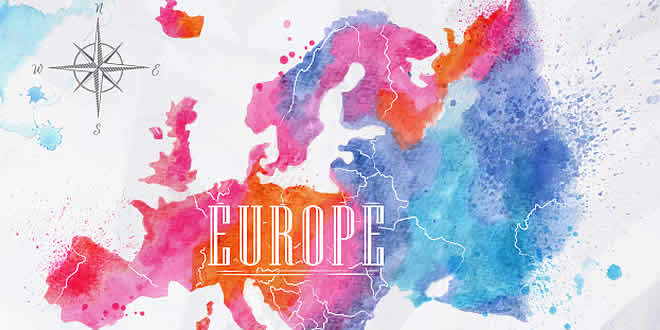Question: Give two examples to show that in the 18th century Europe there were no nation states.
Answer: In the mid-eighteenth-century Europe there were no ‘nation-states’ as we know them today. The countries such as Germany, Italy and Switzerland, which we know today were divided into kingdoms, duchies and cantons whose rulers had their autonomous territories. Eastern and Central Europe were under autocratic monarchies within the territories of which lived diverse peoples. They did not see themselves as sharing a collective identity or a common culture. Often, they even spoke different languages and belonged to different ethnic groups.
The Habsburg Empire that ruled over Austria – Hungary, for example, was a patchwork of many different regions and peoples. It included the Alpine regions – the Tyrol, Austria and the Sudetenland – as well as Bohemia, where the aristocracy was predominantly German-speaking. It also included the Italian-speaking provinces of Lombardy and Venetia.
In Hungary, half of the population spoke Magyar while the other half spoke a variety of dialects. In Galicia, the aristocracy spoke Polish. Besides these three dominant groups, there also lived within the boundaries of the empire, a mass of subject peasant peoples Bohemians and Slovaks to the north, Slovenes in Carniola, Croats to the south, and Roumans to the east in Transylvania. Such differences did not easily promote a sense of political unity. The only tie binding these diverse groups together was a common allegiance to the emperor.
Question: What were the reforms made by Napoleon?
Answer: Within the wide swathe of territory that came under his control, Napoleon set about introducing many of the reforms that he had already introduced in France. Through a return to monarchy Napoleon had, no doubt, destroyed democracy in France, but in the administrative field he had incorporated revolutionary principles in order to make the whole system more rational and efficient.
The Civil Code of 1804 – usually known as the Napoleonic Code –did away with all privileges based on birth, established equality before the law and secured the right to property. This Code was exported to the regions under French control. In the Dutch Republic, in Switzerland, in Italy and Germany, Napoleon simplified administrative divisions, abolished the feudal system and freed peasants from serfdom and manorial dues. In the towns too, guild restrictions were removed. Transport and communication systems were improved.
Peasants, artisans, workers and new businessmen enjoyed a new-found freedom. Businessmen and small-scale producers of goods, in particular, began to realize that uniform laws, standardized weights and measures, and a common national currency would facilitate the movement and exchange of goods and capital from one region to another. However, in the areas conquered, the reactions of the local populations to French rule were mixed. Initially, in many places such as Holland and Switzerland, as well as in certain cities like Brussels, Mainz, Milan and Warsaw, the French armies were welcomed as harbingers of liberty. But the initial enthusiasm soon turned to hostility, as it became clear that the new administrative arrangements did not go hand in hand with political freedom. Increased taxation, censorship, forced conscription into the French armies required to conquer the rest of Europe, all seemed to outweigh the advantages of the administrative changes.
Question: Why were the Middle class so named?
Answer: Socially and politically, a landed aristocracy was the dominant class on the continent. The members of this class were united by a common way of life that cut across regional divisions. They owned estates in the countryside and also town-houses. They spoke French for purposes of diplomacy and in high society. Their families were often connected by ties of marriage. This powerful aristocracy was, however, numerically a small group. The majority of the population was made up of the peasantry. To the west, the bulk of the land was farmed by tenants and small owners, while in Eastern and Central Europe the pattern of landholding was characterized by vast estates which were cultivated by serfs.
In Western and parts of Central Europe the growth of industrial production and trade meant the growth of towns and the emergence of commercial classes whose existence was based on production for the market. Industrialization began in England in the second half of the eighteenth century, but in France and parts of the German states it occurred only during the nineteenth century. In its wake, new social groups came into being: a working-class population, and middle classes made up of industrialists, businessmen, professionals. In Central and Eastern Europe these groups were smaller in number till late nineteenth century. It was among the educated, liberal middle classes that ideas of national unity following the abolition of aristocratic privileges gained popularity.
Question: What led to the spread of conservatism in Europe and what were its impacts?
Answer: Following the defeat of Napoleon in 1815, European governments were driven by a spirit of conservatism. Conservatives believed that established, traditional institutions of state and society – like the monarchy, the Church, social hierarchies, property and the family – should be preserved. Most conservatives, however, did not propose a return to the society of pre-revolutionary days. Rather, they realized, from the changes initiated by Napoleon, that modernization could in fact strengthen traditional institutions like the monarchy. It could make state power more effective and strong. A modern army, an efficient bureaucracy, a dynamic economy, the abolition of feudalism and serfdom could strengthen the autocratic monarchies of Europe.
Question: What were the highlights of the Treaty of Vienna 1815?
Answer: In 1815, representatives of the European powers – Britain, Russia, Prussia and Austria – who had collectively defeated Napoleon, met at Vienna to draw up a settlement for Europe. The main highlights were to how the nation could develop and what economic measures could help forge this nation together.
 Class Notes NCERT Solutions for CBSE Students
Class Notes NCERT Solutions for CBSE Students





